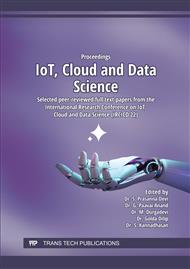[1]
C. M. Mohammed and S. R. Zebaree, Sufficient comparison among cloud computing services: IaaS, PaaS, and SaaS: A review,, Int. J. Sci. Bus., vol. 5, no. 2, p.17–30, (2021).
Google Scholar
[2]
A. Ahmim, M. Derdour, and M. A. Ferrag, An intrusion detection system based on combining probability predictions of a tree of classifiers,, Int. J. Commun. Syst., vol.31, no. 9, p. e3547, (2018).
DOI: 10.1002/dac.3547
Google Scholar
[3]
D. Ucuz, Comparison of the IoT Platform Vendors, Microsoft Azure, Amazon Web Services,and Google Cloud, from Users' Perspectives,, 2020, p.1–4.
DOI: 10.1109/isdfs49300.2020.9116254
Google Scholar
[4]
K. Gupta, D. Gupta, S. K. Prasad, and P. Johri, A Review on Cryptography based Data Security Techniques for Cloud Computing,, 2021, p.1039– 1044.
DOI: 10.1109/icacite51222.2021.9404568
Google Scholar
[5]
S. Shamshirband, M. Fathi, A. T. Chronopoulos, A. Montieri, F. Palumbo, and A. Pescapè,Computational intelligence intrusion detection techniques in mobile cloud computing environments: Review, taxonomy, and open research issues,, J. Inf. Secur. Appl., vol. 55, p.102582, (2020).
DOI: 10.1016/j.jisa.2020.102582
Google Scholar
[6]
A. Kim, M. Park, and D. H. Lee, AI-IDS: Application of deep learning to real-time Web intrusion detection,, IEEE Access, vol. 8, p.70245– 70261, (2020).
DOI: 10.1109/access.2020.2986882
Google Scholar
[7]
G. Aswini and R. Mervin, A Survey on Cloud Security Issues and Threats,.
Google Scholar
[8]
Ranaweera, Pasika, Vashish N. Imrith, Madhusanka Liyanag, and Anca Delia Jurcut. Security As a service platform leveraging multi-access edge computing infrastructure provisions., In ICC 2020-2020 IEEE International Conference on Communications (ICC), pp.1-6. IEEE, (2020).
DOI: 10.1109/icc40277.2020.9148660
Google Scholar
[9]
G. Javadzadeh and A. M. Rahmani, Fog computing applications in smart cities: A systematic survey,, Wirel. Netw., vol. 26, no. 2, p.1433–1457, (2020).
DOI: 10.1007/s11276-019-02208-y
Google Scholar
[10]
Z. R. Al Ashhab, M. Anbar, M. M. Singh, Y.-B. Leau, Z. A. Al-Sai, and S. A. Alhayja'a, Impact of coronavirus pandemic crisis on technologies and cloud computing applications,, J. Electron. Sci. Technol., vol. 19, no. 1, p.100059, (2021).
DOI: 10.1016/j.jnlest.2020.100059
Google Scholar
[11]
P. Ranaweera, V. N. Imrith, M. Liyanag, and A. D. Jurcut, Security as a service platform leveraging multi-access edge computing infrastructure provisions,, 2020, p.1–6.
DOI: 10.1109/icc40277.2020.9148660
Google Scholar
[12]
U. S. Musa, M. Chhabra, A. Ali, and M. Kaur, Intrusion detection system using machine learning techniques: A review,, 2020, p.149–155.
DOI: 10.1109/icosec49089.2020.9215333
Google Scholar
[13]
Z. Ahmad, A. Shahid Khan, C. Wai Shiang, J. Abdullah, and F. Ahmad, Network intrusion detection system: A systematic study of machine learning and deep learning approaches,, Trans. Emerg. Telecommun. Technol., vol. 32, no. 1, p. e4150, (2021).
DOI: 10.1002/ett.4150
Google Scholar
[14]
S. M. Kasongo and Y. Sun, A deep learning method with wrapper based feature extraction for wireless intrusion detection system,, Comput. Secur., vol. 92, p.101752, (2020).
DOI: 10.1016/j.cose.2020.101752
Google Scholar
[15]
R. Abou Khamis, M. O. Shafiq, and A. Matrawy, Investigating Resistance of Deep Learning- based IDS against Adversaries using min-max Optimization,, 2020, p.1–7.
DOI: 10.1109/icc40277.2020.9149117
Google Scholar
[16]
N. Chaibi, B. Atmani, and M. Mokaddem, Deep Learning Approaches to Intrusion Detection: A new Performance of ANN and RNN on NSL-KDD,, 2020, p.45–49.
DOI: 10.1145/3432867.3432889
Google Scholar
[17]
M. A. Ferrag, L. Maglaras, S. Moschoyiannis, and H. Janicke, Deep learning for cyber security intrusion detection: Approaches, datasets, and comparative study,, J. Inf. Secur. Appl., vol. 50, p.102419, Feb. 2020,.
DOI: 10.1016/j.jisa.2019.102419
Google Scholar
[18]
P. S. Muhuri, P. Chatterjee, X. Yuan, K.Roy, and A. Esterline, Using a long short-term memory recurrent neural network (LSTM-RNN) to classify network attacks,, Information, vol. 11, no. 5, p.243, (2020).
DOI: 10.3390/info11050243
Google Scholar
[19]
B.Zhang, H. Zhang, G. Zhao, and J. Lian, Constructing a PM2.5 concentration prediction model by combining auto-encoder with Bi-LSTM neural networks,, Environ. Model. Softw., vol.124, p.104600,Feb.2020,.
DOI: 10.1016/j.envsoft.2019.104600
Google Scholar
[20]
Mehanović, D., Kečo, D., Kevrić, J. et al. Feature selection using cloud-based parallel genetic algorithm for intrusion detection data classification. Neural Comput & Applic (2021).
DOI: 10.1007/s00521-021-05871-5
Google Scholar
[21]
Asghari, A., Sohrabi, M.K. & Yaghmaee, F. Task scheduling, resource provisioning, and load balancing on scientific workflows using parallel SARSA reinforcement learning agents and genetic algorithm. J Supercomput 77, 2800–2828 (2021).
DOI: 10.1007/s11227-020-03364-1
Google Scholar
[22]
Kečo, D., Subasi, A. & Kevric, J. Cloud computing- based parallel genetic algorithm for gene selection in cancer classification. Neural Comput & Applic 30, 1601–1610 (2018).
DOI: 10.1007/s00521-016-2780-z
Google Scholar


